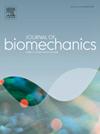年轻人步态运动波动表型的分类。
IF 2.4
3区 医学
Q3 BIOPHYSICS
引用次数: 0
摘要
步幅之间的波动是步态的自然变化。这些波动以个体间差异为特征,表明可能存在不同的波动策略(即表型)。本研究调查步态波动表型的存在。研究人员测量了51名年轻、健康的男性和女性在跑步机上以自己喜欢的速度行走时的全身运动学。测量上半身和下半身32个关节角度的运动波动指标(即变异性的大小、局部动态稳定性和规律性)。通过主成分分析将这些指标简化为主成分(pc),然后使用k-means方法将其分组为簇。采用单因素方差分析检验运动波动pc的聚类差异。提取了3个pc,解释了全部96个电机波动指标的39.7%。PC1得分越高,代表所有关节的波动越大;PC2得分越高,代表上肢波动越大,下肢波动越少;PC3得分代表波动的规律性越小。在54.0%的迭代中,PC得分最高的是四组。各组1-4的PC1评分差异有统计学意义(p本文章由计算机程序翻译,如有差异,请以英文原文为准。
Classification of young adult motor fluctuation phenotypes in gait
Stride-to-stride fluctuations are natural in gait. These fluctuations are marked by inter-individual variability, suggesting that different fluctuation strategies (i.e., phenotypes) may exist. This study investigates the presence of gait fluctuation phenotypes. Whole-body kinematics were measured from young, healthy males and females (N = 51) while walking on a treadmill at their preferred speed. Motor fluctuation metrics (i.e., magnitude of variability, local dynamic stability, and regularity) were measured for 32 joint angles across the upper and lower body. These metrics were reduced to principal components (PCs) via principal component analysis and then grouped into clusters using the k-means method. One-way ANOVAs were conducted to test for cluster differences in motor fluctuation PCs. Three PCs were extracted, explaining 39.7 % of all 96 motor fluctuation metrics. Higher PC1 scores represent more fluctuation across all joints, higher PC2 scores represent greater upper limb fluctuations with fewer fluctuations in the lower limb, and PC3 scores represent less regularity in fluctuations. PC scores best grouped into four clusters in 54.0 % of iterations. Clusters 1–4 each had a significantly different PC1 score (p < 0.022), and Cluster 3 had a higher PC2 score than all other clusters (p < 0.022). Motor fluctuations in treadmill gait of young adults were characterised by four gait fluctuation phenotypes, interpreted as repeaters, replacers, moderate fluctuators, and mixed fluctuators (i.e. more upper limb but fewer lower limb fluctuations); extending the repeaters vs replacers hypothesis. The identified phenotypes add a new perspective that may help clarify the link between motor fluctuations and gait instability.
求助全文
通过发布文献求助,成功后即可免费获取论文全文。
去求助
来源期刊

Journal of biomechanics
生物-工程:生物医学
CiteScore
5.10
自引率
4.20%
发文量
345
审稿时长
1 months
期刊介绍:
The Journal of Biomechanics publishes reports of original and substantial findings using the principles of mechanics to explore biological problems. Analytical, as well as experimental papers may be submitted, and the journal accepts original articles, surveys and perspective articles (usually by Editorial invitation only), book reviews and letters to the Editor. The criteria for acceptance of manuscripts include excellence, novelty, significance, clarity, conciseness and interest to the readership.
Papers published in the journal may cover a wide range of topics in biomechanics, including, but not limited to:
-Fundamental Topics - Biomechanics of the musculoskeletal, cardiovascular, and respiratory systems, mechanics of hard and soft tissues, biofluid mechanics, mechanics of prostheses and implant-tissue interfaces, mechanics of cells.
-Cardiovascular and Respiratory Biomechanics - Mechanics of blood-flow, air-flow, mechanics of the soft tissues, flow-tissue or flow-prosthesis interactions.
-Cell Biomechanics - Biomechanic analyses of cells, membranes and sub-cellular structures; the relationship of the mechanical environment to cell and tissue response.
-Dental Biomechanics - Design and analysis of dental tissues and prostheses, mechanics of chewing.
-Functional Tissue Engineering - The role of biomechanical factors in engineered tissue replacements and regenerative medicine.
-Injury Biomechanics - Mechanics of impact and trauma, dynamics of man-machine interaction.
-Molecular Biomechanics - Mechanical analyses of biomolecules.
-Orthopedic Biomechanics - Mechanics of fracture and fracture fixation, mechanics of implants and implant fixation, mechanics of bones and joints, wear of natural and artificial joints.
-Rehabilitation Biomechanics - Analyses of gait, mechanics of prosthetics and orthotics.
-Sports Biomechanics - Mechanical analyses of sports performance.
 求助内容:
求助内容: 应助结果提醒方式:
应助结果提醒方式:


